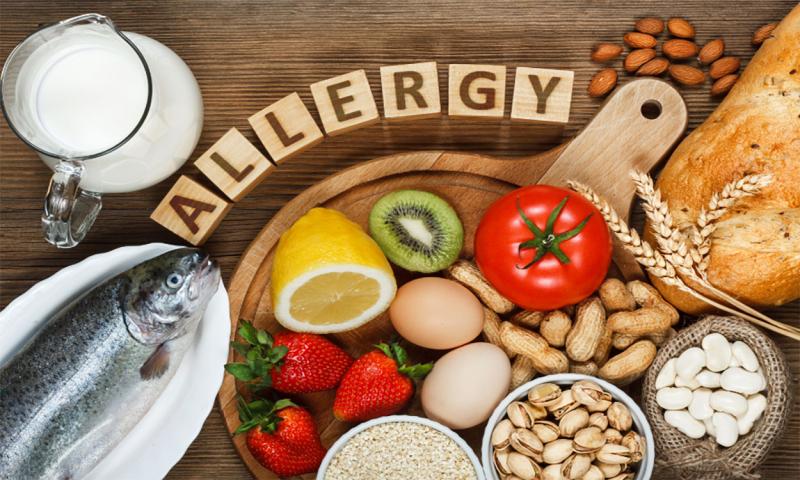Written by Claudia Botzet, former SDSU Extension Nutrition Field Specialist.
In the United States, about 8% of children and 10% of adults are affected by a food allergy.
What is a Food Allergy?
A food allergy is an immune system response that occurs minutes to 2 hours after eating a particular food. Depending on the severity of the allergy, even the slightest amount of the allergy-causing food can cause a reaction. An example of this would be a vanilla-frosted donut touching a peanut-butter-frosted donut in the display stand at a bakery. If someone consumes the vanilla frosted donut and has a severe allergy to peanuts, they may have a reaction, even though no peanut butter frosting is seen on the vanilla donut. For those with food allergies, their bodies recognize one or more of the proteins in the food as an outside invader. This threat is called an allergen, and the immune system produces antibodies that attack the allergen.

Food allergy symptoms can be different for everyone. The most-common food allergy symptoms include:
- Stomach aches, diarrhea, nausea, and vomiting
- Tingling or itching in the mouth
- Hives, itching, or eczema
- Swelling and inflammation in the throat, lips, tongue, and face
- Lightheadedness or fainting
- Wheezing, congestion, or trouble breathing
In very severe cases, anaphylaxis can occur. This is when an allergic reaction causes life-threatening symptoms, including a swollen throat (making it hard to breathe and swallow), rapid pulse, shock with a drop in blood pressure, severe dizziness, and possible loss of consciousness. If you or someone you know experiences anaphylaxis symptoms after eating a known or unknown food allergen, seek medical treatment immediately. Individuals who have severe food allergies should have access to an epinephrine pen, or “Epi-Pen.” These pens are made to inject the hormone epinephrine into the bloodstream, decreasing the body's allergic reaction. Epinephrine aids in relaxing the muscles in the throat, stomach, intestines, and bladder, balancing pressure.
Food Allergy Management

The general way to manage a food allergy is by eliminating the offending food from the diet. Eliminating the food from the diet helps prevent symptoms and reduce risk of an allergic reaction.
In addition, people with food allergies must watch out for cross-contamination. This is when a food that does not have a certain food allergen comes in contact with the food allergen, making it unsafe to eat. Depending on the severity of the allergy, even the slightest amount of exposure to a food allergen can cause a reaction. An example of this would be a vanilla-frosted donut touching a peanut-butter-frosted donut in the display stand at a bakery. If someone with a severe peanut allergy consumes the vanilla frosted donut, they may have a reaction, even if no peanut butter frosting is seen on the vanilla donut.
An individual can have a food allergy to any food. However, the U.S. Food and Drug Administration declares the following 9 foods as the most-common food allergens.
Most-Common Food Allergens
-
Milk
Milk allergies are most common in infants and young children. However, studies have shown about 80% of children grow out of their milk allergy. -
Eggs
Egg allergies are also most common in children. The largest multi-national study on food allergies found 50% of children outgrow their egg allergy by age 5. Several other studies have concluded very similar results. -
Peanuts
Peanuts are one of the most-common allergens associated with anaphylaxis. Many schools have policies declaring them peanut-free facilities. The policies have been put into place for the safety of children who suffer from peanut allergies and the severe reactions that can occur if they are in the same room with peanuts. -
Tree Nuts
Tree nuts include, but are not limited to: almonds, Brazil nuts, cashews, hazelnuts, pistachios, and walnuts. Peanuts are considered legumes, not nuts; however, studies have shown between 25% and 40% of individuals who have a peanut allergy also have an allergy to one or more tree nuts. -
Fish
Fish allergy symptoms do not appear until adulthood for 40% of individuals. The most-common fish species people are allergic to are salmon, tuna, and halibut. This allergen is rarely outgrown.
-
Wheat
Wheat allergies are most common in children. About two-thirds of children outgrow wheat allergies by the age of 12. Wheat allergies and Celiac disease are not the same thing. Celiac disease is an auto-immune disorder triggered by the gluten protein found in wheat, barley, and rye. -
Shellfish
Just like fish, allergic reactions and symptoms for shellfish often do not occur until adulthood. There are two groups of shellfish: 1) crustacea, which includes lobsters, crabs, shrimp and prawns; and 2) mollusks, which include mussels, oysters, scallops, squid, octopus, and cuttlefish. -
Soy
Like many of the most-common allergens, soy is most common in children and is commonly outgrown. Soy is a common ingredient in infant formulas. -
Sesame
A recent study indicated that 1.5 million children and adults in the United States may have a sesame allergy. Other studies have indicated the burden of sesame allergies has increased over the past two decades. Sesame is the most-recent allergen added to the major allergen list.
These 9 allergens must be listed on the nutrition facts label on all food products in the United States. To see where the common allergens are listed on the food label, see Let’s Break Down the Nutrition Facts Label.
As a reminder, food allergies are not limited to milk, eggs, fish, shellfish, peanuts, tree nuts, wheat, soy, and sesame. All bodies are different and may react to different foods.
References
- U.S Food & Drug Administration. Food Allergies.
- Food Allergy Research & Education. Common Allergens.
- American College of Allergy, Asthma & Immunology. Milk & Dairy. Tree Nuts.
- Anaphylaxis UK. Outgrowing A Food Allergy.
- John Hopkins Medicine. Allergies and the Immune System.
- Mayo Clinic. Food Allergy.


